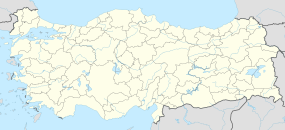Āņi

The ruins of Ani
|
|
| Location | Ocaklı (nearest settlement),Kars Province, Turkey |
|---|---|
| Region | Armenian Highlands |
| Coordinates | 40°30′27″N 43°34′22″E / 40.50750°N 43.57278°ECoordinates: 40°30′27″N 43°34′22″E / 40.50750°N 43.57278°E |
| Type | Settlement |
| History | |
| Founded | 5th century (first mentioned) |
| Abandoned | 17th century |
| Periods | Middle Ages |
| Cultures | Armenian (predominantly) |
| Official name | Archaeological Site of Ani |
| Type | Cultural |
| Criteria | ii, iii, iv |
| Designated | 2016 (40th session) |
| Reference no. | 1518 |
| State Party | Turkey |
| Region | Europe and North America |
Ani (Armenian: Անի; Greek: Ἄνιον, Ánion;Latin: Abnicum;Georgian: ანისი, Anisi;Turkish: Ani) is a ruined medieval Armenian city now situated in the Turkey's province of Kars and next to the closed border with Armenia.
Between 961 and 1045, it was the capital of the Bagratid Armenian kingdom that covered much of present-day Armenia and eastern Turkey. Called the "City of 1001 Churches", Ani stood on various trade routes and its many religious buildings, palaces, and fortifications were amongst the most technically and artistically advanced structures in the world. At its height, the population of Ani probably was on the order of 100,000.
Long ago renowned for its splendor and magnificence, Ani was sacked by the Mongols in 1236 and devastated in a 1319 earthquake, after which it was reduced to a village and gradually abandoned and largely forgotten by the seventeenth century. Ani is a widely recognized cultural, religious, and national heritage symbol for Armenians. According to Razmik Panossian, Ani is one of the most visible and ‘tangible’ symbols of past Armenian greatness and hence a source of pride.
The city took its name from the Armenian fortress-city and pagan center of Ani-Kamakh located in the region of Daranaghi in Upper Armenia. Ani was also previously known as Khnamk (Խնամք), although historians are uncertain as to why it was called so.Johann Heinrich Hübschmann, a German philologist and linguist who studied the Armenian language, suggested that the word may have come from the Armenian word "khnamel" (խնամել), an infinitive which means "to take care of". Ani was also the diminutive name of ancient Armenian goddess Anahit who was seen as the mother-protector of Armenia.
...
Wikipedia

